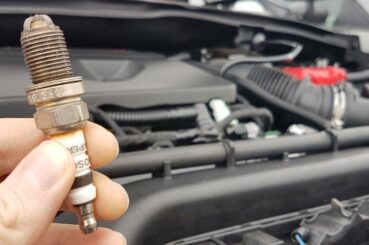Although one of the simpler car parts found under our bonnets, the spark plug is one of the most vital. It is a part that can be often overlooked due to their durability – but as soon as just one of your spark plugs lets go, you’ll be sure to know about it.
Luckily for some, the spark plug is one of the most accessible parts of a car’s engine; usually, anyway. Their handy location allows those with a DIY approach to get their hands dirty easily. However, those who aren’t quite as adept require a little more knowledge and confidence on the matter, and that’s what we’ll cover in this guide.
What are spark plugs and how do they work
Simply put, spark plugs are insulated plugs that are screwed into the cylinder head of an internal combustion engine. Their job is to deliver the spark which ignites the mixture of air and fuel in the combustion chamber, while also transferring heat away from the chamber itself.
On the vast majority of occasions, an engine will have one spark plug per cylinder, with most cars on the road having four cylinders/four spark plugs. Exceptions include HEMI engines (commonly found in muscle cars) which will have two plugs per cylinder.

Going into more detail, the spark plug sits at the top of the cylinder head, and when the piston head first travels down the cylinder, this draws in a mixture of air and fuel. When the piston returns upwards towards the plug, this compresses the mixture and, when at what is referred to top dead centre (TDC), the spark plug sparks and ignites this mixture.
This small explosion of sorts then forces the piston downwards once more to create power for the vehicle and then pushes back up again to clear out the exhaust, and the process begins from scratch. Now, imagine this happening at speed in every cylinder and you’ll get a good idea of what’s going on inside of your car’s engine block.
Do diesel cars have spark plugs? Well, that’s actually a very good question, because no, they don’t. Unlike a petrol-powered vehicle, diesel engines do not use spark plugs to induce combustion.
A diesel engine will instead use compression exclusively to raise the temperature of the air to a level where diesel will combust spontaneously when mixed with this hot air. Something called a glow plug is used in diesel engines and act as heating coils to heat the combustion chamber and help this compression work quicker and more effectively.
How often to change spark plugs
As previously touched upon, spark plugs tend to last quite some time and when to change your spark plugs usually depends upon the mileage since they were last replaced.
A good set of spark plugs should last in the region of 30,000 miles, so it’s best to keep a record of when they were last changed so you know whether you need to think about changing them.
Another sign of when to change your spark plugs can be a dramatic dip in fuel economy. If you’re struggling to reach the level of economy you’ve been accustomed to, there’s a good chance your plugs aren’t running as efficiently as they were, so is a good first point of call in such an instance. This is also possibly the case if you notice a dramatic loss of power when accelerating.

If you hear your engine making a different sound than usual and is producing a more pronounced noise when accelerating, it may be that one or more of your spark plugs have stopped working completely.
Wondering how much replacing your spark plugs might be? For most vehicles, this shouldn’t be too much of an expense, especially if you’re willing to do the work for yourself. A solid set of spark plugs can be bought for £25-35, while the tools required to make the change shouldn’t cost much at all and you might already have some of them.
If you’re looking for a garage to make the change, however, you can contact your nearest Stoneacre dealership to get a quote and make an appointment if necessary. In addition, you can also have your spark plugs changed as part of a comprehensive service on your car.
How to check spark plugs
You can check your spark plugs quite easily for visual signs of wear to indicate problems or a need to change them. Healthy spark plugs will look fairly similar to the way they did when new and first installed depending on how worn they are. Similarly, if they have a slight red coating to them, this is a result of additives used in lower quality fuels and not an indication of a problem with the spark plug itself.
Spark plugs are supposed to be self–cleaning to an extent, in that when they heat up they should burn off the worst of any fuel or ash on them. So a fouled spark plug often indicates a problem and can affect the way your engine is running. If your spark plug has a dry sooty deposit, an encrusted light brown deposit or an oily coating it is likely a fouled spark plug. This can indicate ignition problems, a fuel mixture that is too rich or a plug heat range that’s too low.
A spark plug with cracks or chips in is suffering from detonation or mechanical damage. This can be caused by foreign objects in the engine or a badly set plug. These need fixing promptly as they may lead to piston damage – which can be far more expensive to repair than a spark plug!
A blistered spark plug with a white insulator and eroded electrode is running too hot. It’ll shorten the plugs life and may indicate that the head range is incorrect. While melted electrodes, even if the insulators are white, usually point to a misfiring issue or debris in the combustion chamber – this can lead to engine damage so needs to be fixed quickly.
What spark plugs do I need for my car
You’ll find spark plugs in two basic forms: cold and hot. Which one you choose will depend on what kind of engine your car has and how it works.
If you enjoy a sporty vehicle and are lucky enough to have a high-performance car, then you’ll require cold spark plugs. High-horsepower engines require high compression, creating more heat as a result; this is where a cold plug can help as they have less insulation and are able to transfer more heat away from the combustion chamber.

Those with a car which utilises a more run-of-the-mill engine will make better use of a hot spark plug. This is because they have more insulation to keep the temperature high enough without the higher compression rates of a more powerful engine, helping to burn off carbon deposits and keep the engine running more efficiently.
You’ll also find that spark plugs are available at different levels of quality: copper, platinum, double platinum and iridium. We’ll go into detail regarding these later in the article.
How to change spark plugs
Feel up to the task of tackling a spark plug change yourself?
The general process of replacing your spark plugs is fairly similar car-to-car. However, getting to your plugs can differ between vehicles, so it’s important to ensure you know exactly how to locate them before extraction. Also remember that the engine needs to be cold.
Assuming you have one plug per cylinder, it is important to know that the manufacturer sets an order in which they fire, so make sure you only change one at a time and ensure everything goes back in the place it started.
In terms of tools, the amount you need may differ on just how accessible your plugs are and how comprehensively a job you want to do, but the main tool of use will be a spark plug wrench.
Instead of us explaining the whole process step-by-step, below is one of the most popular and comprehensive videos on the internet showing you how on a visual level:
How to clean spark plugs
Sometimes instead of needing a full change, spark plugs just need a quick clean to get back into good working condition.
Before you remove your spark plugs for cleaning, you need to clean all the dirt out of the area they’re housed in to stop it from falling into your engine cylinders while the plugs are removed. You can use a can of compressed air for this to make it easy or thoroughly wipe with a dry cloth.
Following the instructions on the video guide above, remove and clean one spark plug at a time to avoid confusing which cable goes into which cylinder. Once you’ve removed a spark plug you can use a wire brush and a spray on plug cleaner to scrub the plug clean. For tough deposits you can use sandpaper or a knife to scrape off the build-up, but if it’s a considerable amount it may be better to just change your spark plugs.
What else should I consider with spark plugs
As well as how spark plugs work, there are a few other factors and components worth being aware of.
Variations in spark plug quality:
– The quality scale of spark plugs starts with Copper, which, given they’re made from a softer material than other materials used, will wear quicker and are only usually used in older cars.
– Stepping up from copper is Platinum which takes on a similar mould but use harder, more long-lasting materials and run hotter to get rid of carbon build-up more easily.
– Next up is Double Platinum, with these working slightly differently from standard Platinum plugs and should be the minimum standard of spark plug you should use if recommended in your car’s handbook.
– Iridium spark plugs top the table, lasting generally 25 per cent longer than the Platinum equivalent. Again, don’t downgrade if Iridium are recommended by the manufacturer.

Ignition leads:
– Also known as ignition wires, ignition leads sit atop each of the spark plugs individually to connect them to the likes of a coil pack (more on that in a moment) to help ignite the fuel/air mixture in the cylinders.
– Ignition leads are critical in ensuring an efficient and reliable high voltage transfer to the spark plugs.
– It can be seen as good practice to replace your leads at the same time you replace your plugs to ensure everything in that area is running smoothly.

Ignition coil pack:
– As briefly mentioned above, the ignition coil pack plays an important role in delivering the required voltage to the spark plugs via the ignition leads.
– It is important that your ignition coil is running in good order, as poor ignition can damage the catalytic converter, leading to an expensive fix.
– Again, it can be worth changing the ignition coil pack when replacing leads and plugs if you feel your car might need one.




